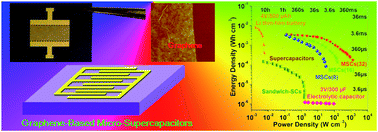Photolithographic fabrication of high-performance all-solid-state graphene-based planar micro-supercapacitors with different interdigital fingers†
Abstract
Here we demonstrated the fabrication of ultrahigh rate, all-solid-state, planar interdigital graphene-based micro-supercapacitors (MSCs) manufactured by methane plasma-assisted reduction and photolithographic micro-fabrication of graphene oxide films on silicon wafers. Notably, the electrochemical performance of MSCs is significantly enhanced by increasing the number of the interdigital fingers from 8 to 32 and minimizing the finger width from 1175 to 219 μm, highlighting the critical importance of adjusting the number and widths of the fingers in the fabrication of high-performance MSCs. The fabricated graphene-based MSCs delivered an area capacitance of 116 μF cm−2 and a stack capacitance of 25.9 F cm−3. Furthermore, they offered a power density of 1270 W cm−3 that is much higher than that of electrolytic capacitors, an energy density of ∼3.6 mW h cm−3 that is comparable to that of lithium thin-film batteries, and a superior cycling stability of ∼98.5% capacitance retention after 50 000 cycles. More importantly, the microdevice can operate well at an ultrahigh scan rate of up to 2000 V s−1, which is three orders of magnitude higher than that of conventional supercapacitors.


 Please wait while we load your content...
Please wait while we load your content...